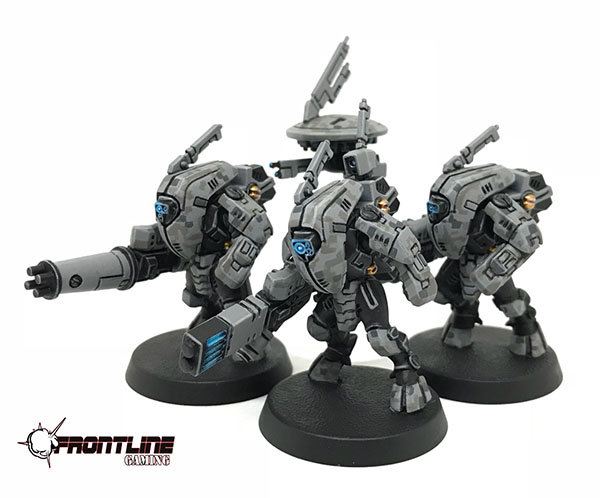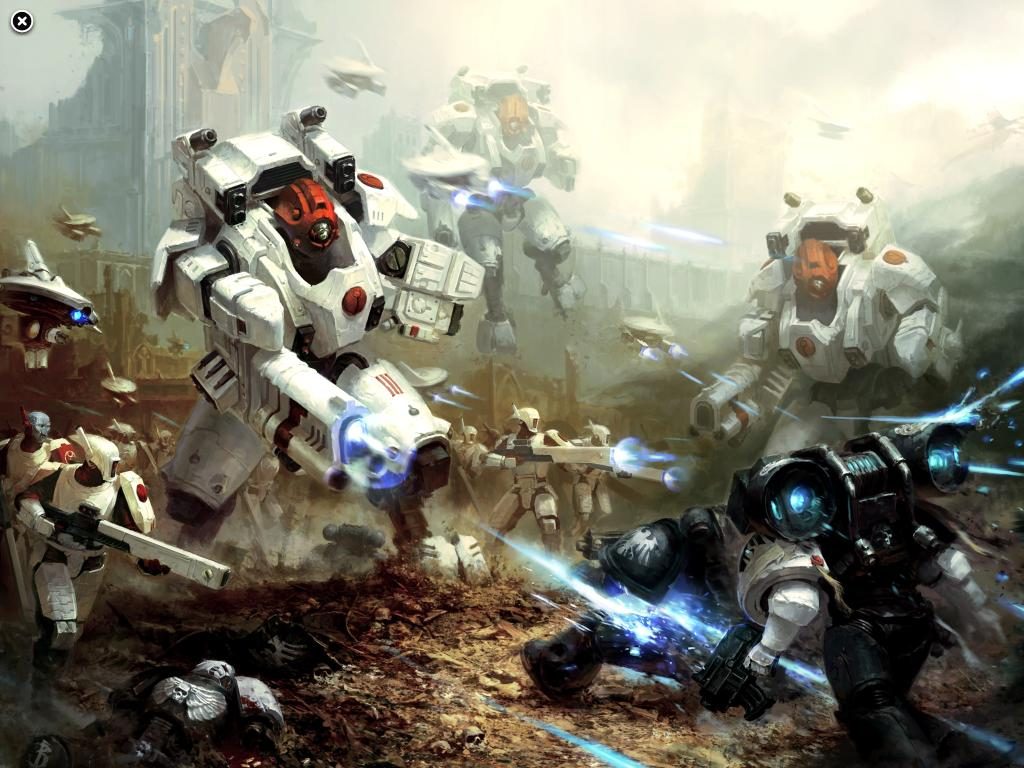While there aren’t many units in the T’au codex that have much utility in 9th edition, XV25 Stealth Suits do offer T’au players some interesting play.
Before we get into some of the cool options that Stealths offer, let’s first acknowledge that both this unit specifically and the codex as a whole needs to drastically improve when the new book is released. This is an obvious point, but it’s worth making note of the context in which we’re discussing this unit.
With that out of the way, what can we say about the humble Stealth team? Here’s a good place to start: the unit’s shooting is relatively poor. Each model is armed with a Burst Cannon, which is an Assault 4, Strength 5, 18 inch range weapon without any AP. Three Stealths will hit on average six times, which isn’t going to do much against most units in the game right now.
As a side note, if you’re interested in what I think the Burst Cannon should look like in the new codex, check out this article here that I wrote a few months back.
But the utility of a Stealth team isn’t found in its offensive output.
One of most interesting points on the XV25 datasheet is the Infiltrate ability. Stealths may setup anywhere on the board that is not within the opponent’s deployment zone and is more than 12 inches from an enemy unit. Almost any unit with this ability, or something similar, is a worth a look in 9th edition 40k.
A confident T’au player will often deploy a unit of three Stealth Suits right on the line of his opponent’s deployment zone. What does such an assertive play achieve? If the T’au players gets turn one, he can jump the unit into the opponent’s table quarter in order to get a turn one ROD.
If the T’au player doesn’t go first, the unit is almost certainly dead, but, at the cost of 78 points for the unit, it’s often worth the risk.
Of course, a slightly more conservative play would be to deploy the unit in an unoccupied table quarter. That way, the unit is much more likely to survive if the T’au player doesn’t get turn one.
But the stylish play is to go for the opponent’s table quarter ROD.
What else do Stealths offer? The unit has an excellent defensive profile that can be bolstered with a five-point upgrade. The base defensive statline of a Stealth Suit is Toughness 4, Wounds 2, Save 3+. So far, so Space Marine. But a Stealth Suit has an in-built -1 to hit rolls against both shooting and melee attacks.
It’s here where we start to see the defensive utility of the unit. While it isn’t difficult to destroy a three-man unit with a -1 to hit, it does force the opponent to think carefully about the weapons that he will use.
Standard anti-infantry firepower, for example, will go some of the way but is unlikely to go all of the way. In order really get the job done, the T’au player’s opponent will probably consider some heavier weaponry.
And this is where the aforementioned five-point upgrade comes in. For 26 points per model, a T’au player gets a Stealth Suit with the defensive statline that I mentioned. However, for 31 points per model, that defensive statline is improved by a 4+ invulnerable save. And it’s here where we start to see the real value of the unit.
For 93 points, then, we have three models with a -1 to hit from both shooting and melee attacks, Toughness 4, a couple of Wounds, a 3+ armour save, and a 4+ invulnerable save.
These models take some shifting.
Don’t get me wrong: every faction has tools that can deal with such a unit, but many players will have to think quite carefully when it comes to distributing firepower to guarantee that the unit is destroyed.
Four Heavy Bolters, for example, should kill two Stealth Suits with average dice, but it only takes a few poor rolls before only one Stealth Suit will die. Or look at it the other way. We all know players who have rolled hot with a 4++.
Should players organise their shooting phases around what might happen or what is most likely to happen? Logically, the latter is the best choice, but logic doesn’t always play a part when we’re talking about 40k.
We’ve established that a Stealth unit can provide some useful options for Secondaries, and we’ve also looked into the strong defensive capabilities of the models.
Let’s stay on the theme of defence. T’au players can, of course, take Drones with their Stealth Suits.
While this is true for many units in the codex, the ability to forward-deploy a couple of Drones can be particularly useful for a handful of reasons.
The utility for Engage is clear enough, but a two-man Drone squad can also be used to tag enemy units in combat. Of course, strong players will find ways to mitigate such a tactic, but it’s a useful tool nonetheless. Opponents will often see Drones as a defensive asset and not an offensive asset, and many a canny T’au player can use this to his advantage.
Finally, I want to mention a particularly cool stratagem to which Stealths Suits have access: Wall of Mirrors.
This stratagem is used in conjunction with a Ghostkeel Battlesuit. A Stealth unit within 6 inches of a Ghostkeel may be removed from the battlefield and setup again no more than 12 inches from the Ghostkeel and more than 9 inches from enemy models. This is, it must be said, a very cool ability.
What’s more, if a Stealth team is in combat, using Wall of Mirrors doesn’t count as Falling Back, meaning that the Stealths are still eligible to, for example, performs actions once the unit is no longer in combat.
Furthermore, it’s quite rare to see this stratagem used in the wild, so any T’au player who pulls it off gets style points for doing so.
Stealth Suits, then, have some play in 9th edition. Are these models the solution to the factions problems in 9th? Absolutely not. Are these models ideal at the moment? Absolutely not. Their offensive profile is still quite poor. Regardless, Stealth Suits in 9th edition have some play, and I’d highly recommend any T’au player who hasn’t already done so to give them a try.
And remember, Frontline Gaming sells gaming products at a discount, every day in their webcart!





